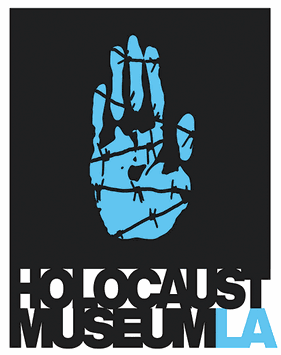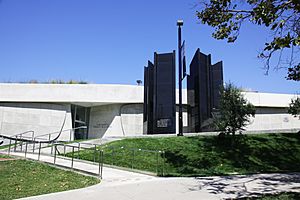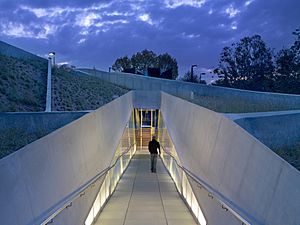Holocaust Museum LA facts for kids
 |
|
 |
|
| Lua error in Module:Location_map at line 420: attempt to index field 'wikibase' (a nil value). | |
| Former name | Los Angeles Museum of the Holocaust |
|---|---|
| Established | 1961 |
| Location | Pan Pacific Park 100 S The Grove Dr Fairfax District, Los Angeles, CA 90036 |
| Type | Holocaust / history museum |
| Visitors | 500,000 |
Holocaust Museum LA is a special museum in Los Angeles, California. It used to be called the Los Angeles Museum of the Holocaust. This museum is located in Pan Pacific Park. It was started in 1961 by people who survived the Holocaust. This makes it the oldest museum of its kind in the United States.
The museum's main goal is to remember the people who died in the Holocaust. It also honors those who survived this terrible time. The museum teaches everyone about the Holocaust. It hopes to inspire a kinder and more respectful world for the future.
Contents
History of the Museum
Holocaust Museum LA is the oldest museum in the United States that was started by Holocaust survivors. In 1961, a group of survivors met in an English class. They realized they all shared a strong desire to remember the past. They started meeting to talk about their own experiences. They felt it was very important to remember their lost family and friends. They also wanted to teach future generations about what happened.
These survivors had many personal items. These included photos, artifacts, and important papers. They decided these items needed a permanent home. This home would be a safe place to keep records, remember, protect, and educate. The museum opened its special underground building in Pan Pacific Park in October 2010. Since then, over 500,000 people have visited the museum.
Learning and Education
Programs for Visitors
It's free for all students and California residents to visit the museum. You can explore the museum on your own. There's a free audio guide to help you learn as you go. Museum staff and guides also offer tours throughout the week.
The museum hosts many public events. These happen both at the museum and online. You can hear conversations with Holocaust survivors. There are also lectures, movie showings, and concerts. In 2020, the museum started a series called "Building Bridges." This program brings together leaders from different communities. They talk about how to work together for fairness and justice.
Learning for Students
Museum tours are made to fit California's school lessons. They follow the state's rules for Holocaust education. Museum staff work with teachers. They make each tour special for the students' age and what they already know. The museum uses personal stories and many real objects. It also uses technology to help students understand this history.
The "Art & Memory" programs are creative and educational. Every year, survivors meet with teenagers. The teens learn about their own heritage. They then retell the survivors' stories. They share their thoughts through art, like film, theater, and photography.
Museum Building Design
In 2010, the museum's board president, Randy Schoenberg, helped the museum move into its permanent home. A famous architect named Hagy Belzberg designed the building. Randy Schoenberg's story of getting a famous painting back from Austria was even shown in the movie Woman in Gold.
The museum building and the park around it are designed to work together. The museum has three main parts. These are the inside museum space, the Goldrich Family Foundation Children's Memorial, and the outdoor Martyrs Memorial.
As you walk through the museum, the light and space change. This is meant to show how time changed through history. The exhibits are set up in order of time. They show Jewish life before the Holocaust. They also cover important events from 1933 to 1945. The museum has a large collection of original items. Holocaust Museum LA has one of the biggest collections of Holocaust artifacts in the United States.
The Children's Memorial is an outdoor area for quiet thought. It remembers the approximately 1.5 million children who died in the Holocaust. There are 1.2 million holes of different sizes in the walls. Visitors can write messages to the children there. A small Garden of the Righteous honors non-Jewish people. These brave people risked their lives to save others.
The Martyr's Memorial monument was built in the early 1990s. It has six 18-foot-high black granite pillars. Each pillar honors the 6 million Jewish people who were murdered in the Holocaust. These pillars also represent the smokestacks of the crematoria.
The building design has won several awards. It received the Los Angeles Cultural Affairs Commission Design Honor Award. It also won the Green Building Design Award and a Gold LEED rating. This LEED rating is a national standard for buildings that are good for the environment. The museum's award-winning design helps tell the sad and important history inside.
Exhibitions to Explore
- Tour Holocaust Museum LA from Home!
- Dimensions in Testimony: Renee Firestone.
- Tree of Testimony: This is a special video sculpture with 70 screens. It shows 52,000 stories from Holocaust survivors. These stories are from the USC Shoah Foundation. Visitors can use their audio guides to listen to any of the 70 stories playing. Since there are so many stories, each survivor's story is shown at least once a year. This means every visitor will hear a different story. At any time, survivors might be speaking in up to 32 different languages.
- The Sobibor Model: Sobibor was one of the six main death camps built by the Nazis. It was part of a plan to kill all the Jews in Poland. A survivor named Thomas Blatt built a model of the Sobibor Extermination camp from his memory. This model is always on display at Holocaust Museum LA. There is also a video screen above the model. On it, Blatt talks about his time in the camp. Blatt was one of 250 prisoners who planned and carried out an escape from Sobibor. He was one of only about 50 who survived.
- Symbols of Hate
- Childhood Left at the Station
- Children's Memorial
Museum Expansion Plans
The number of visitors to the museum grew a lot since 2011. Because of this, plans for an expansion were made in 2021. The new area will be called the Jona Goldrich Campus. Architect Hagy Belzberg will design it. It will have new indoor and outdoor spaces. This will double the museum's size in Pan Pacific Park. The museum hopes to reach more people and be more visible. In June 2022, Susan and Eric Smidt gave $5 million to help build the Jona Goldrich Campus.
A new Learning Center Pavilion will be built next to the current building. It will have a special theater for the USC Shoah Foundation’s Dimensions in Testimony. This theater will have 200 seats. It will be used for movies, concerts, meetings, and public events. The Learning Center Pavilion will also have outdoor spaces for quiet thought. It will have two classrooms for large student groups and programs for younger kids. There will also be a special exhibit space.
In addition, a new Boxcar Pavilion will be built on top of the existing building. This pavilion will hold a real boxcar. This boxcar was found outside of the Majdanek death camp in Poland.
See also
- History of the Jews in Los Angeles
- Jews and Judaism in Los Angeles topics
- Austrian Holocaust Memorial Service of Austrian Service Abroad — Holocaust Museum LA participates
- List of Holocaust memorials and museums in the United States


